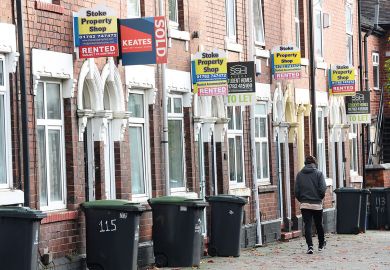New types of student accommodation, including smaller “pod-sized” rooms of just 10 square metres, could help solve the UK’s student housing crisis and reduce rents by up to 30 per cent, according to a new paper.
The proposals by Martin Blakey, former chief executive of the student housing charity Unipol, are designed to convince universities to build a lower-cost accommodation option for less well-off students.
Higher interest rates and increased regulation are affecting the student housing market, while the small uplift in the maximum maintenance loan in England will not keep up with rising rental prices.
Mr Blakey says in the paper that the current model of purpose-built student accommodation (PBSA) is “inherently high-cost”, so a less expensive model needs to be developed with a lower level of servicing and consumer expectations.
The paper, published by the Higher Education Policy Institute (Hepi) on 15 February, proposes smaller buildings of about 300 to 350 student beds to get the best fit on running costs, smaller “pod-sized” en suite rooms of about 10 square metres, and communal spaces for lounge and study areas.
The paper also advocates for a new adjustable energy supplement on rents and mixing up room sizes and facilities within one building, with rooms differentially priced.
Mr Blakey told Times Higher Education that innovations such as the 10 square metre rooms – similar in size to those of the popular Yotel hotel chain – were needed because the sector has been “stuck” on the issue for a long time.
“Everyone’s talking about affordability, but without changing the product design I can’t see how that’s going to happen. It’s just words,” he said.
The paper said the designs could allow for a rent level that is about 25 per cent to 30 per cent below the current PBSA model, and would attract students of all incomes who would rather spend their resources on other things.
Mr Blakey said he was slightly surprised that the sector had not come up with the idea already because PBSA rents have been getting more and more expensive for at least the past decade and have now reached a “certain critical point”.
“In many areas, rent is now your entire maintenance loan, and in some areas it’s more than that,” he said.
“If you look at the general economic situation and parents’ ability to support their own students, there’s just less money in the system.”
Delivering such buildings would require educational institutions to enter into arrangements both to promote them and ensure student balance within them.
“If you’re a private sector developer, you’re not going to innovate because it’s too risky,” added Mr Blakey.
“They have very little incentive to develop something new and lower-cost, and in order to do that they’re going to need to partner with an education institution.”
Register to continue
Why register?
- Registration is free and only takes a moment
- Once registered, you can read 3 articles a month
- Sign up for our newsletter
Subscribe
Or subscribe for unlimited access to:
- Unlimited access to news, views, insights & reviews
- Digital editions
- Digital access to THE’s university and college rankings analysis
Already registered or a current subscriber?








